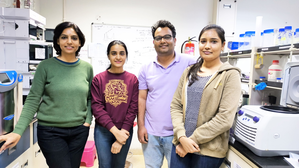IISER Bhopal's new technology to aid in drug development
By IANS | Published: February 7, 2024 06:42 PM2024-02-07T18:42:42+5:302024-02-07T18:45:11+5:30
Bhopal, Feb 7 A team of scientists at the Indian Institute of Science Education and Research (IISER) Bhopal ...

IISER Bhopal's new technology to aid in drug development
Bhopal, Feb 7 A team of scientists at the Indian Institute of Science Education and Research (IISER) Bhopal have developed a technology for attaching chemical tags to proteins, an important process in the development of drugs.
Proteins are extremely prone to loss of function when treated with chemical reagents. However, for the first time, the novel technique eliminates this problem.
The technology, called Baylis Hillman orchestrated Protein Aminothiol Labelling (BHoPAL), efficiently tags chemicals to proteins without compromising their function.
The findings, published in the peer-reviewed journal Nature Communications, showed thay this technology easily allows chemical agents to be attached to any site of the protein, a process that was very difficult to achieve before.
This is a promising development that shall find applications in disease diagnosis, cellular imaging, drug development, and understanding drug-target interactions on a molecular level.
"Proteins are cellular entities that play crucial roles in all cellular functions. Protein dysfunction results in major life-threatening diseases such as Alzheimer's disease, Parkinson's disease, etc.," said Dr. Dimpy Kalia, Assistant Professor, Department of Chemistry, IISER Bhopal, in a statement.
"Hence, developing effective approaches to study proteins in cells is crucial for developing therapeutic approaches targeting them," she added.
To test the platform, the researchers developed a new chemical reaction that has never been explored before.
It occurred between N-Cysteine, an important amino acid present in proteins, and Baylis Hillman adducts, and results in the formation of a linkage (a bis-heterocyclic scaffold) on specific sites on the protein.
Labelling multiple sites of a protein is extremely difficult, but by using this approach, researchers can easily accomplish this task within a few minutes.
"What we have developed has diverse applications in chemical biology, synthetic chemistry, and medicinal chemistry. Protein conjugates fabricated using our BHoPAL technology shall be employed for the fabrication of antibody-drug conjugates (ADCs) for cancer therapy," Dr. Kalia said.
"Moreover, the BHoPAL technology shall also contribute tremendously to basic biological research by enabling the imaging of proteins within human cells."
Disclaimer: This post has been auto-published from an agency feed without any modifications to the text and has not been reviewed by an editor
Open in app